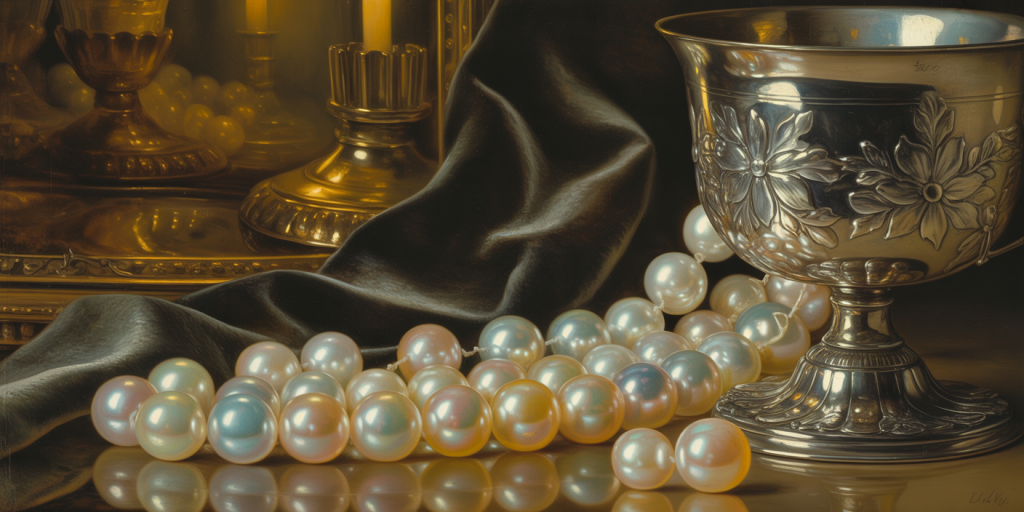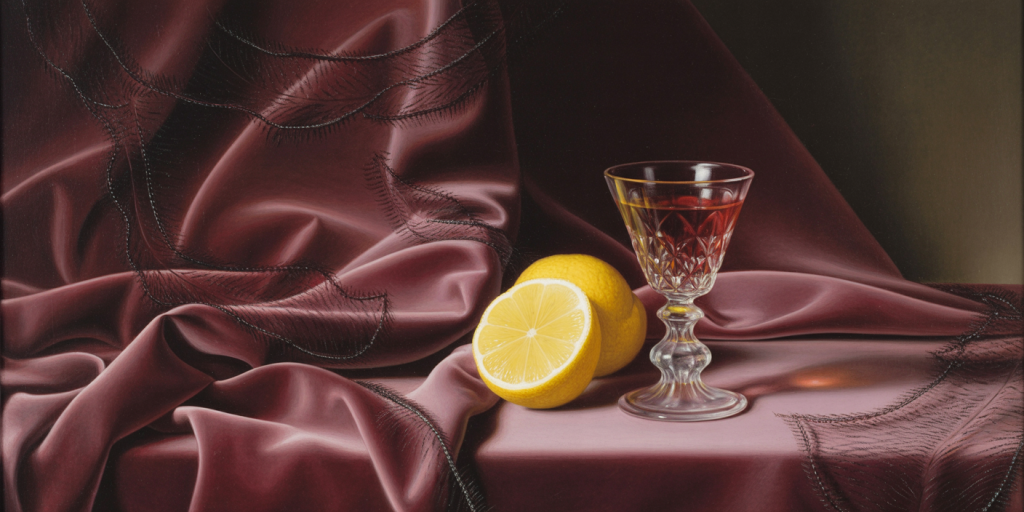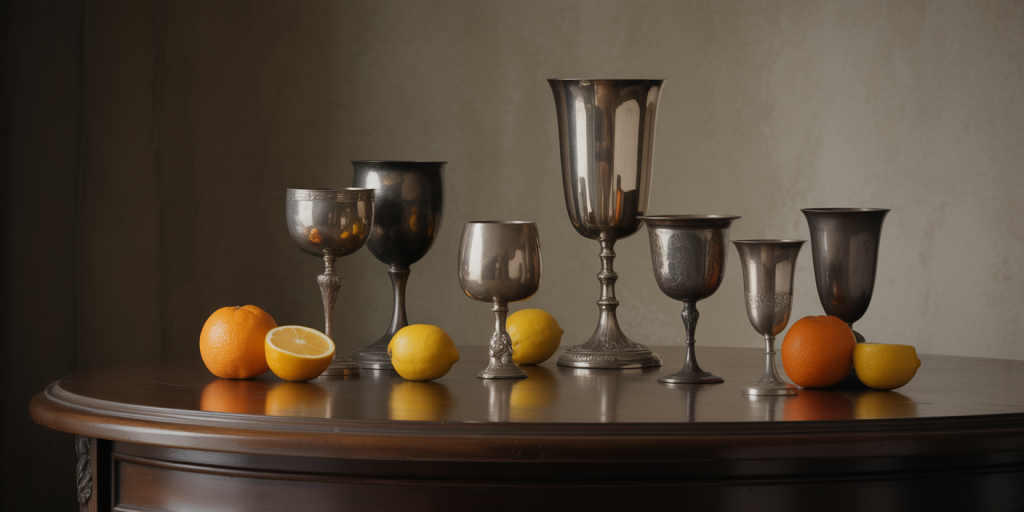The Pearls That Weep in the Eyes of Clara Peeters
Clara Peeters
A Quiet Radiance Between Teeth and Light
In the hush of a still life, the world breathes gently—through oysters barely opened, through goblets that glint like tears suspended in time. And within this suspended world, Clara Peeters whispers. Her brush does not scream; it invites the eye to lean closer. Her canvases glimmer with restrained opulence, with the hush of emotion pressed into petals and pewter.
Behind the reflection on a knife’s blade, something human peers back—a face, perhaps hers, perhaps ours. Her pearls do not simply shine; they weep. Through delicate objects, Clara captured the vulnerability of wealth, the frailty of beauty, and the silent ache that lingers between abundance and absence. Her still lifes are not static—they are confessions wrapped in lace and lemon peel.
Table of Contents
- Pearls that Weep but Do Not Fall
- The Knife That Holds Her Face
- Banquets at the Edge of Silence
- Shadows that Smell of Clove
- Lemons Unraveled Like Secrets
- Glass That Sighs with Light
- The Weight of a Golden Spoon
- When Bread Becomes Memory
- Lilies That Linger in Loss
- Oysters and the Intimacy of Flesh
- Silver that Trembles with Time
- Velvet Echoes of the Absent
- Fragrance Trapped in Paint
- Fruit at the Moment Before Decay
- The Feminine Gaze as Thread
- Intimacy Composed,Desire Compressed
- The Still Life as Silent Soliloquy
- Between Opulence and Melancholy
Pearls that Weep but Do Not Fall
Clara’s pearls do not merely adorn—they mourn. Resting in gentle curves around goblets or nestled in bowls, they glisten like unshed tears. Their luster is never excessive, always a little bruised by shadow. They suggest stories not told, letters not sent, glances held too long in silence.
Symbolically, the pearl evokes purity, but in Peeters’ compositions, it also trembles with fragility. Their placement is never accidental—they form emotional punctuation marks, pauses in a sentence of gold and oil. Their gleam is not boastful, but mournful.

The Knife That Holds Her Face
In many of her paintings, a small reflection appears on the blade of a knife. A miniature self-portrait. A whisper of her presence, folded into steel. This subtle intrusion reclaims authorship, a declaration within the world of objects: “I was here.”
It is both daring and discreet. A woman painter in the early 1600s hiding herself not in the background, but in the sharp edge of things. The knife does not threaten—it reveals. Her gaze flickers in the silver, steady and still, watching us watch.
Banquets at the Edge of Silence
Her feasts are not indulgent. They sit at the moment just before—the lemon is half-peeled, the bread untouched, the oyster unopened. The stillness holds breath, as if someone were about to reach in.
The silence is almost musical. It is the pause in a madrigal, the quiet before a prayer. Her compositions are frozen banquets, not of appetite, but of observation.
Shadows that Smell of Clove
The shadows in her works are not empty—they carry scent. One can almost smell the spiced wine, the dried cloves, the orange oils glistening on rind. Her darkness breathes warmth, not void.
Technically, this mastery of chiaroscuro was rare among women of her time. Emotionally, it adds depth—a slow descent from richness into longing. Her shadows are not cold—they are contemplative.
Lemons Unraveled Like Secrets
Few artists have peeled a lemon as evocatively as Clara. The spiral curl descends like a ribbon loosened from a corset. It falls in tension and elegance, hinting at what is hidden beneath.
This peel is more than fruit—it is invitation and seduction. It reveals without exposure, plays with form, and suggests layers of revelation, as if the truth were always citrus-scented and slightly bitter.
Glass That Sighs with Light
Her glassware holds not just wine or water—it captures atmosphere. Each goblet refracts light like a captured sigh. The curves bend and blur the world behind them, softening the background into memory.
Glass is fragile but unforgiving. To paint it requires technical precision and emotional restraint. Clara gives it both, making her vessels feel half-spoken, like thoughts too delicate to name.
The Weight of a Golden Spoon
A spoon in Clara’s hand is no simple utensil—it becomes a symbol. Its placement, its glint, its bend of light—all deliberate. Gold in her work never screams; it hums.
The spoon reflects more than taste—it suggests legacy, power, gender. In still life, objects bear social code. Clara’s utensils are not about function; they are about roles women were meant to play—and how she redefined them.
When Bread Becomes Memory
Her bread is never warm. It is cool, perhaps a day old. Not decadent, not lavish—but real. Cracked crust, soft interior, touched by time.
There is something monastic in her depiction of food. It resists extravagance. Her bread recalls meals taken alone, quiet nourishment, the sanctity of enough.
Lilies That Linger in Loss
Floral elements in Clara’s work rarely dominate, but when present, they haunt. A single lily droops in a goblet’s mouth. A rose fades in the corner. These are not botanical studies—they are love letters left unfinished.
Their petals hold echoes of funeral and feast, their stems like veins leading nowhere. Flowers are beauty’s punctuation—blooming just long enough to remember that all beauty fades.
The Self Hidden in Reflection
More than once, Clara hides herself within her objects—a ghost in the chalice, a whisper in the blade. Her self-portrait is not centered—it is found, uncovered, earned.
This technique is rare and profound. She speaks through reflection rather than declaration. She does not demand space—she claims it with subtlety. The reflection becomes an echo of agency.
Oysters and the Intimacy of Flesh
Oysters in Clara’s paintings open themselves—delicate, moist, vulnerable. They are not merely food—they are metaphors for exposure, for intimacy, for the tender underside of wealth.
Their pearlescence mirrors the jewels nearby, creating a sensual dialogue between shell and necklace. Flesh and adornment. The sacred and the bodily. They ask: what does luxury cost the soul?
Silver that Trembles with Time
Silver in her works is never too polished. It shows wear, reflection, the slight distortion of age. It feels held, used, passed down.
This tarnished elegance holds meaning. Silver represents not only wealth but memory. It is the heirloom of emotion, the artifact of inheritance. Through it, time trembles quietly in shine.
Velvet Echoes of the Absent
The backgrounds often feature dark velvets—draped, pooled, soft as breath. They serve not only to highlight the objects, but to evoke what is not shown: the room, the air, the body leaning close.
Velvet speaks of absence—of chairs just vacated, of voices no longer heard. It is a tactile darkness. It absorbs light, and with it, narrative.
Fragrance Trapped in Paint
Though we cannot smell her work, Clara paints scent. The orange oils, the spice jars, the faint sheen of butter—all suggest aroma. Her canvas becomes olfactory memory.
This sensory evocation is not decorative—it is affective. Fragrance becomes an extension of touch, a memory that lingers even after the eye turns away. She paints what cannot be held.
Fruit at the Moment Before Decay
Her fruits are never perfect. They bruise. They wrinkle. They are ripe to the point of rot. This temporal tension deepens the emotional field—abundance is fleeting.
Clara captures the moment just before loss. A fig about to split. A plum dimpling under time. These fruits are allegories, tender metaphors of transience.
Light Draped Over Hunger
Her lighting is soft but not shy. It caresses objects, wraps them in gold. But it does not overwhelm. The light in her paintings feels hungry but restrained—like yearning taught discipline.
It falls on surfaces as if it had walked there. Light and object do not compete—they conspire. Together, they offer the viewer an atmosphere of reverent intimacy.
The Feminine Gaze as Thread
Peeters’ gaze is not the male gaze inverted—it is entirely different. It threads connection through emotion, through touch, through placement. Her gaze does not conquer—it weaves.
She observes not to dominate, but to understand. Her gaze is one of care, of critique wrapped in delicacy. It is both direct and veiled, like lace over a mirror.
Intimacy Composed, Desire Compressed
There is desire in her work, but not explicit. It simmers beneath surfaces—the glint of silver, the curve of fruit, the tension of peel. This desire is not for bodies—but for meaning, for presence.
Her compositions compress feeling into objects. Nothing is unnecessary. Everything points inward, like secrets arranged on a table.
The Still Life as Silent Soliloquy
Her still lifes are not scenes—they are speeches. Each object a word, each reflection a pause. Together, they form a soliloquy not spoken aloud, but whispered through presence.
They do not perform. They confess. And in that confession, they invite us to see—not just the table, but ourselves.
Between Opulence and Melancholy
In Clara’s universe, luxury always walks with loss. Gold lies beside wilted leaves. Pearls rest next to bones of fish. The sublime is always shadowed by silence.
Her stillness is not sterile—it is sacred. She reminds us that beauty, in its purest form, always carries the scent of its own departure. That even joy, when perfectly rendered, weeps just a little.
FAQ – Understanding Clara Peeters and Her Art
Who was Clara Peeters?
Clara Peeters (c. 1589–after 1657) was a pioneering Flemish still-life painter, one of the few known women artists of the early Baroque period. She specialized in highly detailed and symbolic compositions.
What themes dominate her work?
Peeters’ art explores themes of transience, wealth, feminine presence, and the passage of time. Her still lifes often include symbolic foods, reflective metals, and subtle self-portraits.
What made her self-portraits so unique?
She often hid tiny reflections of herself in metallic objects such as knives or goblets—an early, subtle assertion of authorship and identity, rare for a woman in her time.
How does her technique stand out?
Her technical precision in depicting textures like glass, metal, and fruit is exceptional. She combines detailed observation with emotional restraint, creating quiet but powerful scenes.
Was she recognized in her time?
Though limited by gender expectations, Peeters achieved notable success and was collected by wealthy patrons. Her works appeared in Antwerp and Amsterdam, and she was one of the first women to gain recognition in still life.
Where can her works be seen today?
Her paintings are featured in major museums such as the Prado Museum (Madrid), Mauritshuis (The Hague), and the Rijksmuseum (Amsterdam).
Final Reflections – When Silence Wears Pearls
Clara Peeters did not need mythological scenes or grand narratives. She painted the edge of a table and made it eternal. Her works are not about noise—they are about nuance.
She placed emotion inside apricots, identity inside goblets, and longing inside ribbons of peel. Her brush did not shout—it whispered into the soul’s ear.
And in those quiet banquets, between pearls that do not fall and spoons that reflect secrets, we find something rare: a woman’s gaze made immortal—not by scale, but by subtlety. Not by noise, but by the weeping light of her stillness.


